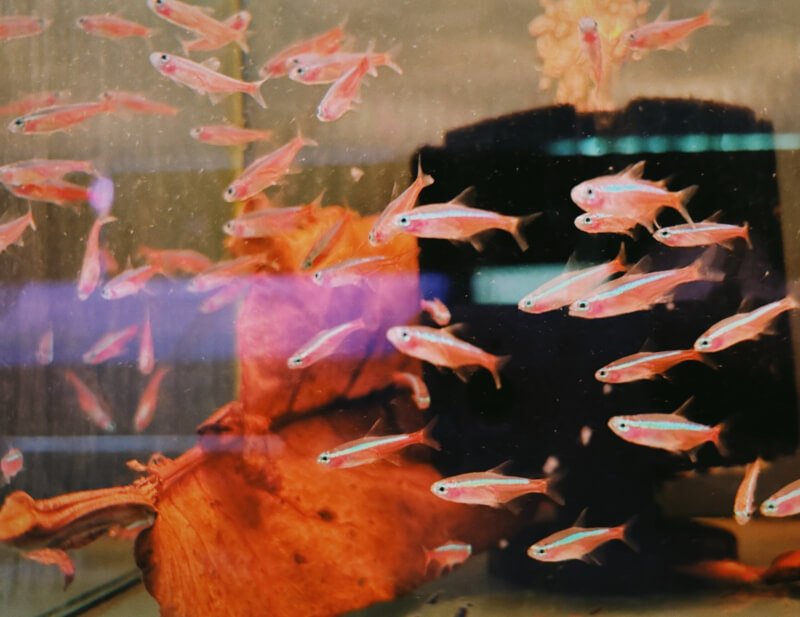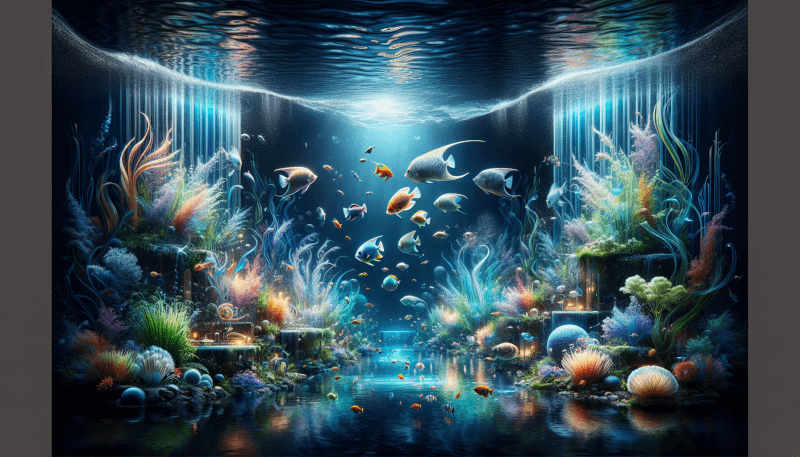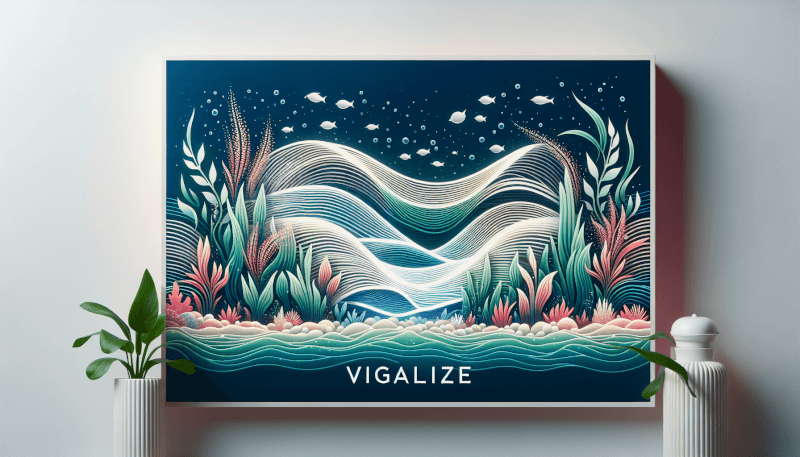Imagine creating a peaceful sanctuary in the comfort of your own home, where you can escape from the chaos of everyday life and immerse yourself in a tranquil atmosphere. In this article, we explore the art of building a serene and tranquil aquarium aesthetic. From selecting the perfect fish species to designing a visually stunning underwater landscape, we provide you with expert tips and guidance on how to create an aquarium that not only serves as a captivating centerpiece but also promotes a sense of calm and relaxation. With our guidance, you can transform your living space into a haven of serenity that will leave both you and your guests in awe.
Choosing the Right Aquarium
When it comes to creating a serene and tranquil aquarium, choosing the right aquarium is the first step. There are a few things to consider when determining the size and shape of your aquarium. The size of your aquarium will depend on the space you have available and the number of fish you plan to keep. It’s important to remember that larger tanks are generally easier to maintain as they provide more stability in terms of temperature and water quality.
In addition to the size, the shape of the aquarium also plays a role in creating the desired aesthetic. Rectangular or square tanks are popular choices as they offer a wide viewing area and allow for more flexibility in terms of aquascaping. However, if you’re looking for a unique and eye-catching design, you may consider a cylindrical or bow-front tank.
When it comes to the material of the aquarium, there are a few options to choose from. Glass aquariums are the most common choice as they are durable and provide clear visibility. Acrylic aquariums, on the other hand, are lighter and offer better insulation, but they are more prone to scratches.
Before making any final decisions, it’s important to assess the available space in your home or office. Consider the dimensions and find a suitable location where the aquarium will not be in direct sunlight or near any drafts. Keep in mind that accessibility is also important for maintenance purposes.
Lastly, don’t forget to research different brands and models to find the one that fits your needs and budget. Read reviews, talk to experts, and visit local aquarium stores to get a better sense of the options available to you.
Creating the Ideal Environment
Once you’ve chosen the right aquarium, it’s time to create the ideal environment for your fish and plants. This involves selecting appropriate water temperature, optimizing water quality, choosing suitable lighting, and incorporating aquatic plants.
The water temperature is crucial for the well-being of your fish. Different species have different temperature requirements, so it’s important to research the specific needs of the fish you plan to keep. Use a reliable aquarium thermometer to monitor the water temperature and invest in a heater to maintain a consistent and comfortable temperature.
Water quality is another important aspect to consider. Provide your fish with clean and well-oxygenated water by investing in a good filtration system. Regularly test the water parameters such as pH, ammonia, nitrites, and nitrates to ensure they are within the appropriate range. Additionally, perform regular water changes to prevent the buildup of harmful substances.
In terms of lighting, it’s important to choose a system that mimics natural daylight. This not only enhances the aesthetic of your aquarium but also promotes the growth of aquatic plants. LED lights are a popular choice as they are energy-efficient and adjustable.
Speaking of plants, incorporating aquatic plants in your aquarium not only adds to the visual appeal but also provides numerous benefits. Plants oxygenate the water, absorb harmful substances, and provide hiding spots for fish. Choose plants that are suitable for your aquarium size and lighting conditions, and make sure to properly anchor them in the substrate.

Selecting the Perfect Fish
Now that you have set up the environment, it’s time to choose the perfect fish to populate your aquarium. This involves researching different fish species, considering compatibility, taking into account the fish’s temperament, and understanding feeding requirements.
Researching different fish species is essential to ensure that the fish you choose are compatible with your aquarium conditions. Consider factors such as the fish’s size, behavior, and water temperature requirements. Make sure to choose fish that are suitable for the size of your tank and can coexist peacefully with each other.
Compatibility is key when it comes to creating a harmonious community in your aquarium. Some fish are social and prefer to be in groups, while others are territorial and may not get along with certain species. Mixing fish with similar temperaments and size is usually the best approach to maintain a peaceful environment.
Taking into account the fish’s temperament is important to avoid any conflicts or stress in the aquarium. Some fish are more aggressive than others and may bully or harass other tank mates. On the other hand, some fish are more timid and may get easily intimidated by more dominant species. It’s important to strike a balance and choose fish that will coexist harmoniously.
Understanding the feeding requirements of your fish is crucial for their health and well-being. Different fish have different dietary needs, so it’s important to research and provide them with a balanced and varied diet. Some fish are herbivores and require plant-based foods, while others are carnivores and need a diet rich in protein. Make sure to feed your fish at appropriate intervals and avoid overfeeding, as this can lead to water quality issues.
Aquarium Layout and Design
The layout and design of your aquarium play a significant role in creating a serene and tranquil atmosphere. This involves considering aquascaping techniques, creating a focal point or centerpiece, utilizing natural elements like rocks and driftwood, and arranging plants and decorations.
Aquascaping refers to the art of designing and arranging elements within the aquarium to create a visually pleasing layout. There are various aquascaping techniques to choose from, including the traditional nature-style, the minimalist style, or the hardscape-focused style. Each technique offers a unique aesthetic and allows for different levels of creativity.
Creating a focal point or centerpiece in your aquarium can enhance its visual appeal and draw attention. This can be achieved by incorporating a unique plant, a striking piece of driftwood, or a decorative rock formation. The focal point should be placed in a way that it serves as a visual anchor and adds depth to the overall design.
Natural elements like rocks and driftwood can be used to create a more authentic and organic look in your aquarium. Rocks can be stacked or placed strategically to create caves or hiding spots for fish. Driftwood not only adds a natural aesthetic but also provides a surface for algae growth, which can be beneficial for some fish species.
Arranging plants and decorations is the final step in creating a well-designed aquarium. Consider the height, shape, and growth rate of the plants when arranging them. Place taller plants towards the back of the tank and shorter plants towards the front to create a sense of depth. Incorporate decorations sparingly to avoid overcrowding the aquarium and allow the fish to swim freely.
Importance of Water Filtration
Water filtration is a critical aspect of maintaining a healthy and thriving aquarium. It plays a crucial role in removing waste, toxins, and other harmful substances from the water. Understanding the role of filtration, choosing the right filtration system, and maintaining it regularly are key to keeping the water conditions optimal.
The role of filtration in an aquarium is to remove physical, chemical, and biological waste from the water. Physical filtration involves removing debris and solid particles through mechanical means, such as a filter pad or sponge. Chemical filtration involves removing chemical impurities through activated carbon or other specialized media. Biological filtration involves cultivating beneficial bacteria that break down toxic waste substances.
Choosing the right filtration system depends on the size of your aquarium and the type of fish you have. There are various types of filters available, including hang-on-back filters, canister filters, and sponge filters. Research the different options and choose one that can handle the waste load of your aquarium and provides adequate filtration.
Maintaining and cleaning the filter regularly is crucial for its effectiveness. Follow the manufacturer’s instructions for cleaning and replacing filter media to ensure optimal performance. Regularly check for any clogs or blockages and clean them accordingly. It’s also important to prime the filter after any maintenance to ensure proper water flow.
Maintaining optimal water conditions is essential for the health and well-being of your fish. Regularly monitor temperature and pH levels using appropriate testing kits. Make any necessary adjustments to the water parameters to keep them within the recommended range. Understanding the nitrogen cycle in aquariums is crucial for maintaining healthy water conditions. Monitor ammonia and nitrite levels, and perform regular water changes to keep them in check.
Maintaining Water Parameters
Maintaining the proper water parameters is vital for the health and longevity of your aquarium inhabitants. By monitoring temperature and pH levels, conducting regular water testing, adjusting water parameters when necessary, and understanding the nitrogen cycle, you can ensure a stable and thriving aquatic environment.
Temperature and pH are two of the most important water parameters to monitor in your aquarium. Most fish have specific temperature requirements, and maintaining a stable temperature within their preferred range is crucial. Invest in a reliable aquarium thermometer and heater to ensure consistent temperatures.
pH levels also play a significant role in the well-being of your fish and other aquatic inhabitants. Different species have different pH requirements, so it’s important to research the specific needs of your fish. Use pH testing kits to regularly monitor the pH levels and make any necessary adjustments using pH buffers or additives.
Regular water testing is essential to assess the overall water quality in your aquarium. Test kits are available for measuring ammonia, nitrites, and nitrates – three key components of the nitrogen cycle. Ideally, ammonia and nitrite levels should be at zero, while nitrates should be kept below certain levels through regular water changes.
In addition to testing the nitrogen cycle components, it’s also important to test other water parameters such as hardness and alkalinity. You can consult with a local aquarium store or a professional to determine the ideal levels for your specific aquarium setup.
Adjusting water parameters when necessary is crucial for maintaining a stable and healthy aquatic environment. Use appropriate products or additives to raise or lower pH, hardness, or alkalinity as needed. However, it’s important to do so gradually and avoid sudden changes that can stress or harm your fish.
Understanding the nitrogen cycle is vital for aquarium owners. It is the natural biological process that converts toxic ammonia, produced by fish waste, into less harmful substances. This process involves the growth of beneficial bacteria in the aquarium filter, which break down ammonia into nitrites and then nitrates. Regular water changes and biological filtration help keep the nitrogen cycle in balance.

Proper Feeding and Nutrition
Proper nutrition plays a crucial role in the health and vitality of your aquarium inhabitants. By researching the dietary needs of specific fish species, providing a balanced and varied diet, determining appropriate feeding frequencies, and avoiding overfeeding, you can ensure that your fish are getting the nutrition they need to thrive.
Researching the dietary needs of specific fish species is essential to provide them with the right type of food. Some fish are herbivores and require plant-based foods, while others are carnivores and need a diet rich in protein. Research the specific nutritional requirements of your fish and choose high-quality commercial foods that meet their needs.
In addition to commercial foods, it’s also beneficial to provide a varied and balanced diet. Supplement the staple diet with occasional treats such as live or frozen foods, like bloodworms or brine shrimp. This helps enrich their diet and provides them with additional nutrients.
Determining the appropriate feeding frequency depends on the species and size of your fish. Some fish require multiple small meals throughout the day, while others may only need one or two feedings. Avoid overfeeding, as it can lead to water quality issues and health problems for your fish. Observe your fish and adjust the feeding frequency accordingly.
Proper portion control is also important when feeding your fish. Feed them only the amount they can consume within a few minutes and remove any excess food to prevent it from decomposing in the tank. Uneaten food can contribute to poor water quality and lead to unwanted algae growth.
Preventing and Treating Health Issues
Ensuring the health and well-being of your aquarium inhabitants requires proactive measures. By recognizing signs of illness or stress, practicing regular quarantine procedures, understanding common diseases in aquarium fish, and seeking professional advice when needed, you can prevent and treat health issues effectively.
Recognizing signs of illness or stress in your fish is crucial for early intervention. Common signs include lethargy, loss of appetite, abnormal swimming behavior, changes in color or appearance, and abnormal growths or lesions. Regularly observe your fish and monitor any changes in their behavior or appearance. If you notice any signs of illness or distress, take prompt action to address the issue.
Practicing regular quarantine procedures can help prevent the introduction of diseases into your aquarium. Before adding any new fish to the tank, it’s recommended to quarantine them in a separate tank for a few weeks. This allows you to observe their behavior and monitor their health before introducing them to your main aquarium. Quarantine tanks should be properly equipped with filtration and heating systems.
Understanding common diseases in aquarium fish is essential for identifying and treating health issues. Research the common diseases that affect the species you keep and learn how to recognize their symptoms. Common ailments include fungal infections, bacterial infections, parasitic infestations, and swim bladder disorders. Keep appropriate medications and treatments on hand to address these issues promptly.
Seeking professional advice when needed is crucial for complex or severe health issues in your aquarium. If you’re unable to diagnose or treat a specific disease or ailment, don’t hesitate to consult a veterinarian or an experienced aquarium hobbyist. Their expertise can help you identify the problem and provide appropriate treatment options.

Maintaining a Clean and Pristine Aquarium
Keeping your aquarium clean and pristine is not only important for aesthetic reasons but also for the health and well-being of your fish. By performing regular water changes and cleaning, removing debris and waste regularly, managing algae growth, and maintaining a proper maintenance schedule, you can ensure a clean and healthy environment for your aquatic inhabitants.
Regular water changes and cleaning play a crucial role in maintaining optimal water conditions. Perform partial water changes every 1-2 weeks, depending on the size and stocking level of your aquarium. This helps dilute harmful substances and replenish essential minerals. Clean the aquarium glass regularly to remove any algae buildup and maintain clear visibility.
Removing debris and waste from the aquarium is important for preventing water quality issues. Use a gravel vacuum or siphon to remove any accumulated waste or uneaten food from the substrate. This helps reduce the nutrient load in the water and prevents the buildup of harmful substances.
Managing algae growth is another aspect of maintaining a clean aquarium. While some algae can be beneficial, excessive growth can be unsightly and harmful to your fish and plants. Maintain a proper balance of light, nutrients, and CO2 to control algae growth. Regularly clean the glass and prune any algae-covered plants.
Having a proper maintenance schedule is essential for staying on top of regular aquarium maintenance tasks. Create a routine that includes water changes, filter maintenance, and equipment checks. This helps ensure that all aspects of your aquarium, from water quality to equipment functionality, are properly maintained.
Creating a Relaxing Atmosphere
Creating a serene and tranquil atmosphere in your aquarium goes beyond just the physical aspects. By adding soothing background music, utilizing calming lighting effects, creating a peaceful viewing area, and avoiding disturbances in the surroundings, you can enhance the overall experience and create a relaxing environment for both you and your fish.
Adding soothing background music can create a peaceful ambiance in your aquarium area. Choose calming and gentle tunes that mimic the sounds of nature, such as ocean waves or soft rain. Avoid loud or jarring sounds that can stress your fish.
Utilizing calming lighting effects can further enhance the atmosphere in your aquarium. Invest in dimmable LED lights that can simulate sunrise and sunset effects. This helps recreate natural lighting conditions and promotes a sense of tranquility in the aquarium.
Creating a peaceful viewing area is important for your enjoyment and relaxation. Set up a comfortable seating area near the aquarium where you can sit and observe your fish. Use cozy cushions or chairs and arrange them in a way that allows for optimal viewing angles.
Avoid disturbances in the surroundings of your aquarium to maintain a serene atmosphere. Keep loud noises, bright lights, and sudden movements to a minimum. Avoid placing the aquarium in high-traffic areas or near sources of excessive noise. This allows your fish to feel secure and promotes a stress-free environment.
In conclusion, building a serene and tranquil aquarium requires careful consideration and planning. From choosing the right aquarium and creating the ideal environment to selecting the perfect fish and maintaining optimal conditions, every aspect plays a crucial role. By following the tips and strategies outlined in this article, you can create a beautiful and calming aquarium that provides a soothing experience for both you and your aquatic inhabitants. With a little effort and attention to detail, you can achieve a serene oasis in your own home or office. Happy aquarium-keeping!


